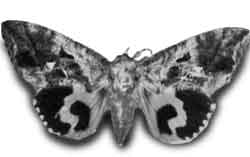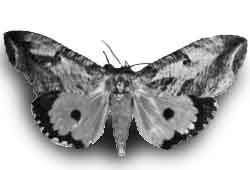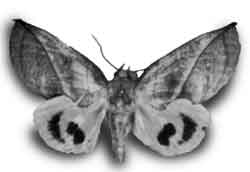
FRUIT-PIERCING MOTH
PRIMARY TROPICAL FRUIT PESTS
Three major pests of tropical fruit growing are flying foxes, fruit piercing moth and fruit spotting bug. Other pests are periodically important on certain fruits but these are generally not perennial. Growing areas of mixed species of fruit probably helps to minimise insect problems.
The flying fox problem should be addressed on a national level, with cooperation between National Parks and Wildlife, CSIRO and the relevant Departments of Agriculture.
The Queensland Department of Primary Industries has undertaken to investigate the fruit piercing moth and fruit spotting bug questions, and CSIRO is also commencing work on fruit piercing moth in S.E. Queensland.
FRUIT PIERCING vs FRUIT SUCKING MOTH
All species of moths recorded feeding on fruit belong to the family 'Noctuidae' (night flying moths). What we, the researchers, call fruit piercing moth and you, the growers, call fruit sucking moth are, for the most part, the same thing.
CSIRO have recommended that we call fruit piercing moths those that can actually pierce the skin or rind of fruit, and fruit sucking moths, those that rely on skin being damaged to gain access to the fruit juices. The problem with such a division is that there is a range of species whose individual piercing ability depends on the hardness of the fruit involved.
A Swiss researcher who studied fruit piercing moths in Thailand recorded no fewer than 88 species of moths that could pierce fruit, the number of fruits that could be pierced by an individual species varying with fruit hardness. Eleven species were confirmed primary piercers of longan, a further eighteen primary piercers of citrus and an additional 59 piercers of soft and very soft fruits (such as raspberry). Only four species of moth caused 60-95% of the damage to the longan and citrus.
DAMAGE CAUSED BY MOTHS
The major primary piercing species have a heavily armoured proboscis* which allows them to attack a wide range of fruits. A species like Othreis fullonia has been recorded on no fewer than 40 different fruits and this is probably a very conservative figure. Some unusual fruits like tomato, capsicum, cashew, coffee, prickly pear, and melon are included in this.
The ability of moths to pierce fruit was first recognised in Australia ca 1875, but was doubted for some time. Fungi and bacteria enter through the hole created by feeding and fruit rot sets in rapidly, in most cases rendering the fruit worthless.
DISTRIBUTION Of FRUIT PIERCING MOTHS
The moths occur largely in tropical and subtropical areas and predominate in Australia and the Pacific, in Asia, Africa, tropical America and some areas of Europe. In Australia, they occur in most tropical and subtropical areas of the east coast and through most monsoonal areas in the north of the country.
THE MOTH SPECIES
The moth species responsible for the bulk of damage in Australia can be listed as follows:
Othreis fullonia - a widely distributed species in Australia and the Pacific, parts of Asia and also Africa. In Thailand, this species alone is estimated to cause 70-90% of primary damage to longan, and 50-70%. to citrus. It appears to be the dominant species active in North Queensland and the most significant pest of lychees here.
Othreis materna - another widely distributed species, in Australia, in the Indian sub-continent and in parts of Africa. In Australia it is the most significant pest of fruits in the Northern Territory and West Australia and in the drier inland areas. Its distribution appears to be governed by its restriction to breeding on only one genus of vine.
| Othreis fullonia | Othreis materna |
 |  |
Eudocima salaminia - another Asian and Australian species which is active right down the Queensland coast and is particularly damaging to citrus in S.E. Queensland. It appears to be more active in early winter when the O. fullonia is less common. In Thailand this species causes CA. 5-12% of damage to longan and 10-20% on citrus.
Othreis jordani - this species was only recognised in Thailand after the Swiss study was complete and has only recently emerged as a significant pest in Australia. As it looks very similar to O. fullonia no doubt it was confused for a long time. From our data, it appears that O. jordini is the most significant pest of carambolas, just in advance of O. fullonia.
| Eudocima salaminia | Othreis jordani |
Adris tyrannus - this is a large, relatively active species in North Queensland but it is considered more of a pest in countries like Japan.
| Adris tyrannus | |
 |
LARVAL HOST PLANT ASSOCIATIONS
Apart from areas of the Pacific where a race of O. fullonia breeds on Erythrina (coral trees), all primary-piercing moth larvae appear to develop on vines of the family Menispermaceae. There are about 22 species of these vines in the Cape York/North Queensland region, but the moths appear to have distinct preferences for just a few of them. The Menispermaceae contain alkaloids and have been involved in stock poisoning, so most work has concentrated on the phytochemical aspects of the family. Our work has commenced to develop a picture of which moth species breed on what vine species, and to determine what the food preferences of the larvae are. This will enable us to predict the build-up of moth populations in response to growth of the vines in the field.
The most important vine species (and I say that with some reservation, as there may be more than one species involved) is Tinospora smilacina (no common name). There are three distinct varieties of this plant.
1. Foreshore and exposed coast variety - this appears to be deciduous during the dry season except where exposed to some moisture (e.g. Buchan's Point and Wangetti Beach).
2. Rainforest variety - apparently not deciduous (e. g. Mission Beach and Cairns Botanic Gardens).
3. Inland (dry area) variety which apparently occurs across northern Australia in those areas influenced by the summer monsoon - deciduous during the dry, from about June to October (e.g. Einasleigh, Dimbulah).
Tinospora has a considerable water storage capacity in the stem (large vascular rays) which enables it to survive in very harsh conditions.
Our experiments show that Tinospora is the favoured larval host plant of O. fullonia, the only genus eaten by the larvae of O. materna and we think it is the host plant of O. jordini.
The activity of these moth species through the dry season is limited by the deciduousness of the host plant. Nevertheless, the plants commence re-growth just prior to the first summer rains, allowing the moths to take full advantage of the new growth once the rains accelerate leaf production.
Part of the success of O. fullonia as a fruit piercer lies in its ability to switch larval hosts, should Tinospora be in short supply or in its deciduous phase. Numerous species of Menispermaceae have been found growing in close proximity to one another.
The only other specific host plant we have encountered is Stephania japonica variety timoriensis (a very widely-occurring species in Australia and Asia). Eudocima salaminia breeds on this plant. This vine grows in rainforest areas and proliferates when the vegetation is disturbed by man.
The more we are able to examine Menispermaceae in the field, the more we'll be able to say of "risk" in the growing fruit trees in certain area. Adult moths are reputed to have great powers of dispersal and there is a reported case of a specimen of O. materna being caught 300 miles out to sea from Mauritius. Nevertheless, our feelings are that orchards close to areas of Tinospora (or rainforest) are at greatest risk.
CONTROL, MANAGEMENT, FORECASTING
Of course our ultimate goal is the control or management of moth activity, using both direct control measures and forecasting techniques.
Moth activity is generally too late to allow for chemical use, and in any case, the moths do not remain in contact sufficiently long to achieve knockdown. So unless some super, quick active synthetic pyrethroid with a very short withholding period, is developed, broadscale chemical application in control of these moths can be ignored.
HISTORY OF CONTROL TECHNIQUES
a] Poisoned baits (still some possibilities here using fruit volatiles).
b] Smoking orchards to mask fruit scents.
c] Repelling with deterrent sprays (citronella mentioned).
d] Orchard sanitation (removing all rotting and fallen fruit).
e] Early harvest (good solution where practical).
f] Capture or destruction of feeding moths by hand or net.
g)] Bagging or screening of fruits.
Apparently carambolas in Malaysia are enclosed in a paper bag prior to ripening and left as such until harvesting. Very labour intensive, netting trees, which may have the double advantage of reducing flying fox damage.
We've heard a figure of $200 quoted per medium-sized tree i.e. using half-inch bird netting.
h] Light repulsion technique - this method appears to hold a good promise. A barrier of lights (550-580 m) (yellow-green wavelengths) is formed around a block of trees, but shining outwards. There should be a 12 m barrier between the lights and surrounding vegetation, so that the moths are denied cover. We have planted a test plot of 4 blocks of carambolas at Walkamin Research Station in order to test this technique.
OTHER CONTROL MEASURES
a] Pheromones - these are sex attractants produced by a female moth to attract the male for mating.
We are doing cooperative work with the University of Queensland and CSIRO Division of Entomology in Canberra, to isolate and produce pheromones from these moths. Some novel compounds with large molecules have been found, differing in trace elements between species. Pheromones, in the first place, would be used as monitoring tools to ascertain major moth activity periods.
They may also have some control application, or result in feeding disruption, as we suspect mating takes place in the fruit tree. As there is a 4.5:male bias in moths feeding (irrespective of species) a pheromone could conceivably limit feeding activity.
b] Biological control - we have identified a fly which parasitises the larvae and a Trichogramma (very small wasp) which parasitises the eggs of primary-piercers. We have also found a lygaeid bug which we suspect may prey on the eggs.
Another fly parasite is known from New Caledonia and has been imported by Fiji as a control agent. It apparently doesn't effectively control O. fullonia in New Caledonia, so its worth in Fiji is questionable. Several other predators and parasites have been identified in the Pacific region. CSIRO are having a closer look at this aspect. Birds, insectivorous bats, etc., all play a role in limiting moth numbers.
c] Decoys - it may be possible to employ the volatile compounds from the larval host plants as decoys to reduce moth breeding by inducing females to lay eggs on plants other than those on which larvae will feed.
FORECASTING
The remainder of our work involves developing an ability to forecast when moths are likely to be a significant problem. This is accomplished through:
a] A determination of the physical conditions which enable population increases
b] Ascertaining the seasonal biological control influences
c] Examining larval host plant associations and growth patterns
d] Elucidating moth dispersal and migratory abilities, and
e] Determining moth species/fruit species interactions.
We are hopeful that something positive from the control viewpoint will be forthcoming in the next twelve months.
DATE: January 1987
* * * * * * * * * * * * *
